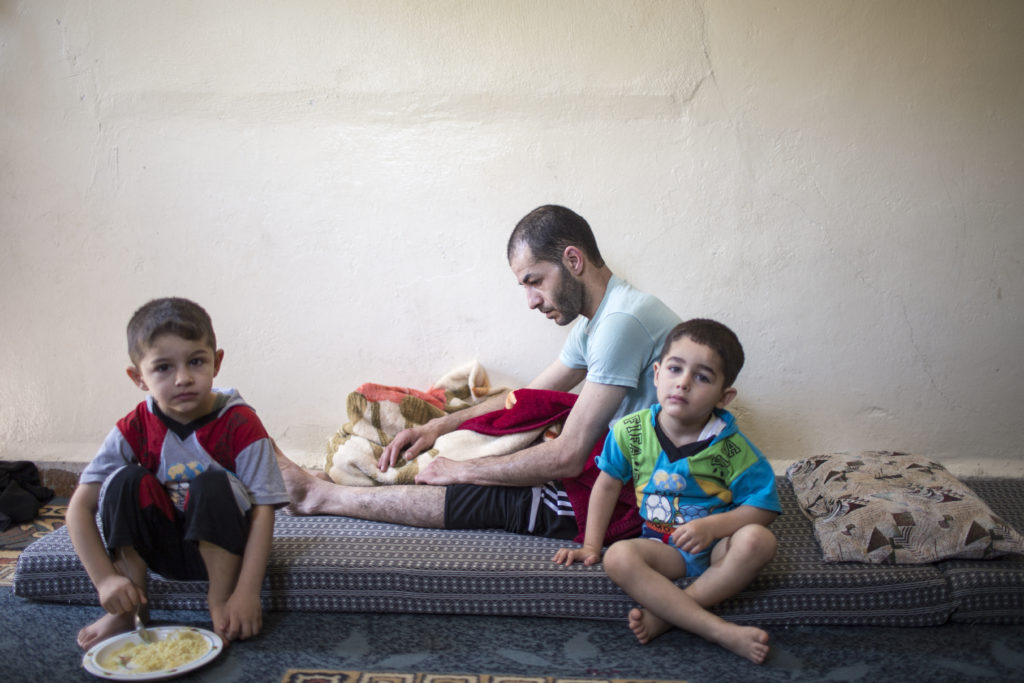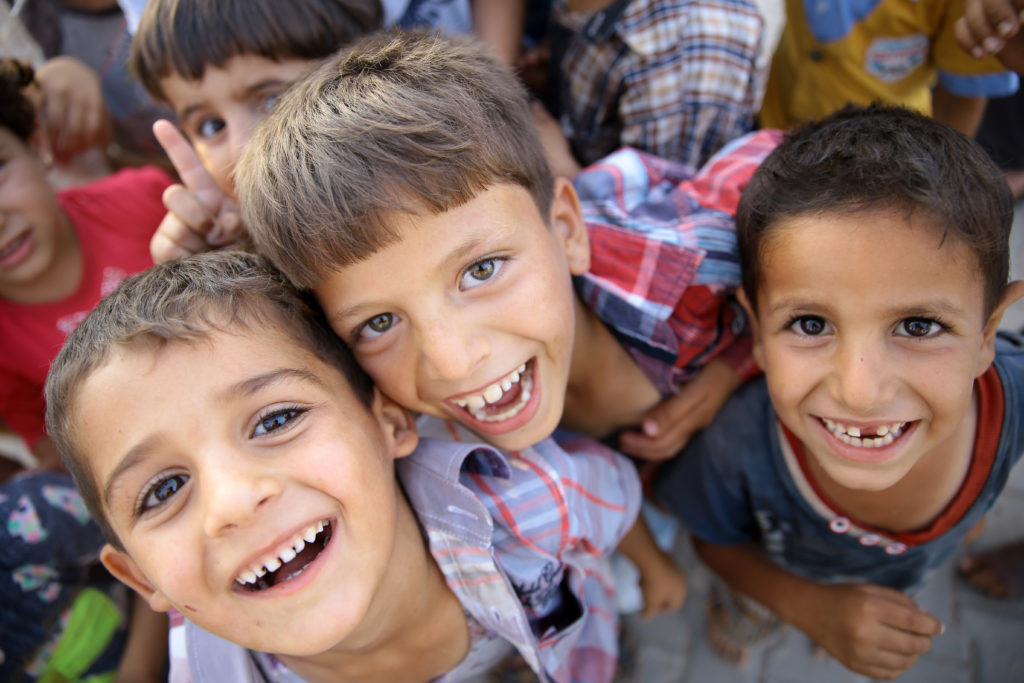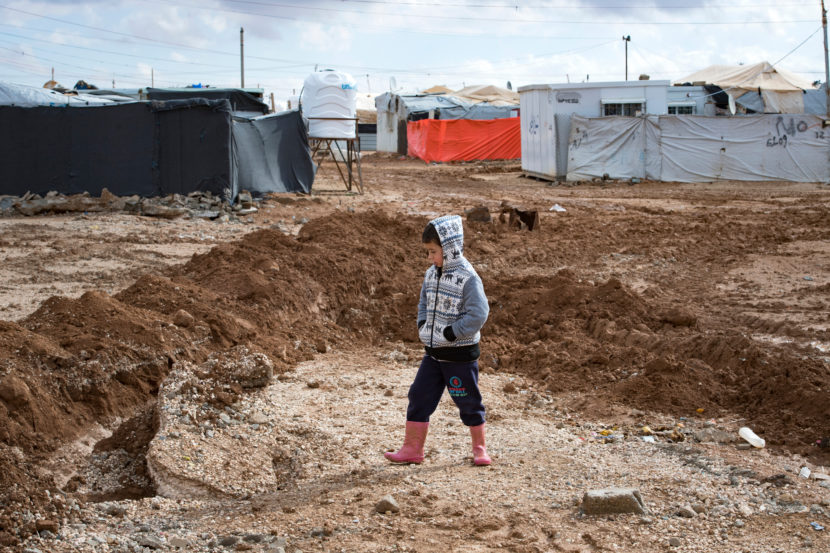Since 1948, Jordan has hosted successive waves of refugees, most recently Syrians and Palestinians fleeing ongoing conflicts. Early aid provided urgent shelter and support, but the long-term presence of large refugee populations has strained resources and deepened inequalities. Refugee children face poverty, malnutrition, barriers to education and healthcare, and legal restrictions that hinder their protection.
Despite national child rights reforms, the absence of a refugee law and restrictive policies limit long-term integration. Without sustainable response to the worsened crisis, these challenges continue to threaten the well-being and future of refugee children in Jordan.
Jordan’s long history of hosting refugees
For decades, Jordan has been a major host country for refugees fleeing regional wars and crises, including Palestinians displaced in 1948 and 1967 (Migration Policy Institute, 2025). In more recent years, the country has also become a primary destination for Syrians escaping the civil war.
The refugee crisis escalated in 2011 with the outbreak of the Syrian conflict, which inflicted widespread violence on civilians. This led to the opening of Jordan’s first large refugee camp, Za’atari, near the Syrian border. The camp sheltered more than 100,000 people in its first year and at its peak housed around 150,000 (UNICEF, 2020; Oxfam, 2025). While the camp has not stabilized its population to an estimate of 80,000 people, the water scarcity and the reduced supply times of electricity affect the daily lives of refugees living in the camp (UNHCR, 2022 and 2024; Global Platform for Action, 2025).
The refugee children at risk in Jordan
Refugee children in Jordan are at risk of severe poverty, which can lead to child labour, child marriage and food insecurity. This issue particularly affects Syrian refugees, fleeing the conflicts in their country for the past 10 years. Additionally, their access to education and essential services, such as birth registration, is impeded by legal and administrative barriers, while their protection and well-being are further threatened by inadequate national resources and humanitarian funding gaps (Human Rights Watch, 2016; UNICEF, 2025).
Approximately 2,39 million Palestinian refugees and around 527,740 refugees from other countries, including Syria, are hosted by Jordan More specifically, 481,116 refugees are from Syria, 31,554 from Iraq, 326 from Somalia, 4,511 from Sudan and 9,718 from Yemen (Amnesty International, 2024; UNHCR, 2025; UNRWA, 2025). Around half of all refugees in Jordan are under the age of 18 (UNESCO, 2023; UNICEF, 2025).
Jordan’s obligations under international and national law
Jordan had ratified the International Convention on the Elimination of All Forms of Racial Discrimination in 1974, the Convention on the Rights of the Child in 1991, together with the optional protocol on the involvement of children in armed conflict in 2007 and on the sale of children child prostitution and child pornography in 2006 (United Nations Treaty Bodies, n.d.). Jordan was the first Arab country to ratify the Convention on the Rights of Persons with Disabilities, and it has also passed a disability rights law (Human Rights Watch, 2023).
Jordan also ratified the Arab Charter on Human Rights in 2004, which entered into force in 2008 (Carnegie Endowment for International Peace, 2015). As such, Jordan has the responsibility and obligation to take measures to protect children, ensure their well-being, and apply these rights to children in a non-discriminative manner.
Jordan has established a comprehensive set of national legislation to ensure the rights of children are protected, including the Child Rights Law, which provides protection against violence, abuse, and exploitation, and ensures rights to health, education, and legal aid (Euro-Med Human Rights Monitor, 2022). Despite this framework, there is no specific national law on refugee children in Jordan. Instead, the country addresses their needs through international agreements and domestic policies which grant children access to public education, healthcare and financial assistance (Human Rights Watch, 2024).
Despite having one of the largest refugee populations in the world, the Jordanian government has not signed any important international agreements about how to treat refugees. This includes the UN’s 1951 Convention Relating to the Status of Refugees and its additional 1967 protocol (Migration Policy Institute, 2025).
Nutrition and education challenges for refugee children
Jordan is facing considerable difficulties in ensuring the welfare of refugee children, especially those from Syria, in the access to education and to essential services. Refugee children in Jordan face two nutritional challenges, including malnourishment and anaemia (UNICEF, 2025). A sizeable proportion of Syrian families are food insecure, with four out of ten lacking sufficient food for a healthy diet (UNICEF, 2018).

In education, refugee children face obstacles. Numerous studies indicate that a significant proportion of students, irrespective of their geographical location or academic standing, are falling short of the expected grade levels in both mathematics and Arabic (UNICEF, 2025). Thirty-eight per cent of Syrian children are not in school due to the cost, lack of space and bullying (UNICEF, 2015; UNICEF, 2018). Children with disabilities are especially affected by the lack of affordable and accessible school transportation (Human Rights, 2023).
The consequences of a lack of nutrition and education for refugee children in Jordan are severe and long-term, impacting their health and cognitive development. It’s like a vicious cycle where poor health and limited education hold them back, making them vulnerable to violence, exploitation and abuse (UNICEF, 2018).
Current barriers to refugee children’s rights
Constant legal and social barriers hamper the rights of refugee children in Jordan. Although Jordan initially permitted Syrians to enter the country freely, albeit with restrictions on employment, it gradually introduced controls (Oxford Academic, 2019). Over the years, it has implemented increasingly protracted displacement policies, including summary deportations and denial of access to important categories of employment (Human Rights Watch, 2021). Even though work permits are available, only 10,2% of non-Syrians and 15% of Syrians are employed, which marks a sharp contrast with the 33,1% of employed Jordanians (UNHCR, 2024)
Unlike Palestinians, Syrian refugees are still legally designated as temporary guests. This status has restricted their access to fundamental rights and services, hindering their integration from the beginning. Beyond that, social integration remains challenging. A considerable number of Syrians have expressed feelings of profound alienation, consequent to their inability to attain legal residency or to participate fully in public life.
Although Jordan has largely maintained social cohesion, tensions have occasionally emerged in host communities. At the same time, public services in the communities where they are based have found it hard to keep up. The situation is particularly acute in northern governorates near the Syrian border, where local health clinics, water supplies and classrooms have been stretched to their limits (Migration Policy Institute, 2025).
These outcomes are inextricably linked to more profound structural and legal constraints. The system for registering refugees and renewing their permits is often inconsistent and difficult to navigate. The management of refugees in Jordan is a complex issue involving many different bodies, including government departments, local councils, United Nations agencies, international donors and non-governmental organisations.
Each of these bodies has its own unique objectives and timeframes. The result is a fragmented policy landscape, where the implementation of national initiatives at the local level often varies due to factors such as geography, available resources, and institutional capacity. The resident’ freedom to leave and re-enter the camps as they please are strictly limited, which has a further impact on life and work opportunities (Migration Policy Institute, 2025).
A paucity of international aid, among other reasons, has left refugees and asylum seekers facing deterioration in their circumstances, including severe limitations on their economic and social rights – the rights to sustenance, water, healthcare, shelter, education and employment among others. Considering that “9 out of 10 resorted to taking on debt to meet their basic needs”, the poverty rate among refugees is alarming as it was recorded at 67% (UNHCR, 2025).
Working toward sustainable solutions for refugee children
For a decade, Jordan has been dealing with the refugee crisis in a humanitarian and urgent manner. Given the state of children’s rights and the living conditions in which refugees are placed, Jordan needs to shift its policies towards a longer-term planning in order address social and economic integration of refugees in a sustainable manner (Saferworld, 2016).
The refugee crisis can be addressed by Jordan through the integration of humanitarian and development aid to create sustainable long-term solutions, the formalisation of refugee employment and livelihoods, the empowerment of local communities and governance, and the investment in infrastructure and public services for both refugees and host communities (Carnegie Endowment for International Peace, 2015; Forced Migration Review, 2024).
It is imperative to fortify institutional capacity and collaboration to establish inclusive and equitable access to registration and documentation systems. This will subsequently enable refugee children to partake in formal education and avail themselves to healthcare services (International Labour Organization, 2013; Human Rights Watch, 2016).
In future, the Jordanian government, working together with international partners, could concentrate on improving vocational training and educational programmes, and make it easier for refugees to find working opportunities (International Rescue Committee, 2016; World Bank, 2024). Jordan should also concentrate on its capacity to assess, observe and record the pressing needs of refugees, as a means of counteracting the obstacles to their protection, health and education (UNESCO, 2023).

Humanium, as a child-right organisation actively conducting numerous projects worldwide, remains committed to safeguarding children’s rights to education, health, and protection. If you want to contribute to Humanium’s specific causes to improve children’s lives, please consider making a donation, volunteering or becoming a member.
Written by Moïra Phuöng Van de Poël
Bibliography:
Aljazeera (2017, May 25). Syrian refugee crisis: All your questions answered. Retrieved from Aljazeera from https://www.aljazeera.com/news/2017/5/25/syrian-refugee-crisis-all-your-questions-answered, accessed in August 2025.
Amnesty International (2024). Jordan. Retrieved from Amnesty International at https://www.amnesty.org/en/location/middle-east-and-north-africa/middle-east/jordan/report-jordan/, accessed in August 2025.
Carnegie Endowment for International Peace (2015, September 21). The Arab Charter on Human Rights. Retrieved from Carnegie Endowment for International Peace at https://carnegieendowment.org/sada/2009/10/the-arab-charter-on-human-rights?lang=en, accessed in August 2025.
Euro-Med Human Rights Monitor (2022, August 3). Children’s Rights bill in Jordan… a positive step, but?. Retrieved from Euro-Med Human Rights Monitor at https://euromedmonitor.org/en/article/5278/Children%27s-Rights-bill-in-Jordan%E2%80%A6-a-positive-step,-but, accessed in August 2025.
Forced Migration Review (2024). The refugee crisis in Lebanon and Jordan: the need for economic development spending. Retrieved from Forced Migration Review at https://www.fmreview.org/dahi/#:~:text=Shifting%20to%20development%20means%20investment,than%20working%20at%20cross%20purposes., accessed in August 2025.
Global Platform for Action (2025, May 19). A Roadmap for Energy Access in Displacement Settings: Jordan. Retrieved from Global Platform for Action at https://www.humanitarianenergy.org/what-is-the-gpa/resources-and-tools/a-roadmap-for-energy-access-in-displacement-settings-jordan/#:~:text=Jordan%20hosts%20one%20of%20the,%2C%20infrastructure%2C%20data%20and%20coordination., accessed in August 2025.
Human Rights Watch (2016). “We’re Afraid For Their Future” – Barriers to Education for Syrian Refugee Children in Jordan. Retrieved from Human Rights Watch at https://www.right-to-education.org/sites/right-to-education.org/files/resource-attachments/HRW_Were_Afraid_For_Their_Future_2016_EN.pdf, accessed in August 2025.
Human Rights Watch (2021, October 20). “Our Lives Are Like Death” – Syrian Refugee returns from Lebanon and Jordan. Retrieved from Human Rights Watch at https://www.hrw.org/report/2021/10/20/our-lives-are-death/syrian-refugee-returns-lebanon-and-jordan, accessed in August 2025.
Human Rights Watch (2023, April 26). Jordan: Submission to the UN Committee on the Rights of the Child. Retrieved from Human Rights Watch at https://www.hrw.org/news/2023/04/26/jordan-submission-un-committee-rights-child, accessed in August 2025.
Human Rights Watch (2024, January). Jordan – Events of 2023. Retrieved from Human Rights Watch at https://www.hrw.org/world-report/2024/country-chapters/jordan#:~:text=Authorities%20continued%20to%20implement%20the,%2C%20verbal%2C%20and%20sexual%20abuse, accessed in August 2025.
International Labour Organization (2013). ILO Response to the Syrian Refugee Crisis in Jordan – Child Labour. Retrieved from International Labour Organization at https://www.ilo.org/projects-and-partnerships/projects/ilo-response-syrian-refugee-crisis-jordan-%E2%80%93-child-labour, accessed in August 2025.
International Rescue Committee (2016). Solvig the Refugee Employment Problem in Jordan: A Survey of Syrian Refugees. Retrieved from International Rescue Committee at https://www.rescue.org/sites/default/files/document/1405/irc-syrianrefugeeemployment-72dpi-041117.pdf, accessed in August 2025.
Migration Policy Institute (2025, June 5). The Fragile Yet Unmistakable Long-Term Integration of Syrian Refugees in Jordan. Retrieved from Migration Policy Institute at https://www.migrationpolicy.org/article/syrian-refugees-jordan, accessed in August 2025.
Oxfam (2025). Life in Za’atari, the largest Syrian refugee camp in the world. Retrieved from Oxfam at https://www.oxfam.org/en/life-zaatari-largest-syrian-refugee-camp-world, accessed in August 2025.
Oxford Academic (2019, May 4). The Syrian Refugee Crisis and Foreign Policy Decision-Making in Jordan, Lebanon, and Turkey. Retrieved from Oxford Academic at https://academic.oup.com/jogss/article/4/4/464/5487959, accessed in August 2025.
Saferworld (2016, April). The Syrian refugee crisis: understanding and responding to tensions and conflicts in Jordan, Lebanon and Turkey. Retrieved from Saferworld at https://www.saferworld-global.org/resources/publications/1054-the-syrian-refugee-crisis-understanding-and-responding-to-tensions-and-conflicts-in-jordan-lebanon-and-turkey, accessed in August 2025.
UNESCO (2023). Understanding trajectories of refugee inclusion in national education systems: policy and data perspectives from Jordan; background paper. Retrieved from UNESCO at https://unesdoc.unesco.org/ark:/48223/pf0000387704.locale=en, accessed in August 2025.
UNHCR (n.d). Who is a ‘refugee’?. Retrieved from UNHCR at https://www.unhcr.org/us/about-unhcr/who-we-protect/refugees, accessed in August 2025.
UNHCR (2022, July 29). Jordan’s Za’atari refugee camp: 10 facts at 10 years. Retrieved from https://www.unhcr.org/news/stories/jordans-zaatari-refugee-camp-10-facts-10-years, accessed in August 2025.
UNHCR (2024, March 22). How water scarcity in Jordan hits refugees twice. Retrieved from UNHCR at https://www.unhcr.org/jo/news/how-water-scarcity-jordan-hits-refugees-twice#:~:text=In%202000%2C%20available%20water%20resources,to%20carry%20them%20back%20home., accessed in August 2025.
UNHCR (2024, December). Socio-Economic Update on Refugees in Jordan – Q4 2024. Retrieved from UNHCR at file:///C:/Users/mpoel/Downloads/Q42024%20FINAL%20Socioeconomic%20Update.pdf, accessed in August 2025.
UNHCR (2025, May 28). Annual Results Report – 2024 Jordan. Retrieved from UNHCR at https://www.unhcr.org/sites/default/files/2025-06/Jordan%20ARR%202024.pdf, accessed in August 2025.
UNHCR (2025, July 31). Jordan Operational Data Portal. Retrieved from UNHCR at https://data.unhcr.org/en/country/jor#:~:text=Total%20Number%20of%20Registered%20Refugees,Source%20%2D%20UNHCR, accessed in August 2025.
UNICEF (2015, March). Access to Education for Syrian Refugee Children and Youth in Jordan host communities – Joint Education Needs Assessment Report. Retrieved from UNICEF at https://www.unhcr.org/innovation/wp-content/uploads/2016/08/REACH_JENA_HC_March2015_.pdf, accessed in August 2025.
UNICEF (2018, February 26). 85 per cent of Syrian children in host communities in Jordan live in poverty. Retrieved from UNICEF at https://www.unicef.org/press-releases/syrian-children-jordan-poverty-unicef, accessed in August 2025.
UNICEF (2020). A timeline of the Syrian civil war and refugee crisis. Retrieved from UNICEF at https://www.unicef.ie/stories/timeline-syrian-war-refugee-crisis/, accessed in August 2025.
UNICEF (2025). Children at risk in Jordan. Retrieved from UNICEF at https://www.unicefusa.org/what-unicef-does/where-unicef-works/middle-east/jordan#:~:text=Children%20at%20risk%20in%20Jordan,reliable%20seasonal%20rainfall%20and%20drought., accessed in August 2025.
UNRWA (2025). Refugee camps in Jordan. Retrieved from UNRWA at https://www.unrwa.org/where-we-work/jordan, accessed in August 2025.
US News (2024, January 5). The Plight of Palestinian Refugees, Explained. Retrieved from US News at https://www.usnews.com/news/best-countries/articles/2024-01-05/explainer-the-complicated-plight-of-palestinian-refugees#:~:text=With%20nearly%202.4%20million%20registered,to%20the%20agency’s%202023%20estimates, accessed in August 2025.
United Nations Treaty Bodies (n.d.). View of the ratification status by country – Jordan. Retrieved from United Nations Treaty Bodies at https://tbinternet.ohchr.org/_layouts/15/TreatyBodyExternal/Treaty.aspx?CountryID=11&Lang=EN, accessed in August 2025.
World Bank (2024, October 22). The economic impacts of the Syrian refugee migration on Jordan: A trade perspective. Retrieved from World Bank at https://blogs.worldbank.org/en/developmenttalk/the-economic-impacts-of-the-syrian-refugee-migration-on-jordan–, accessed in August 2025.


